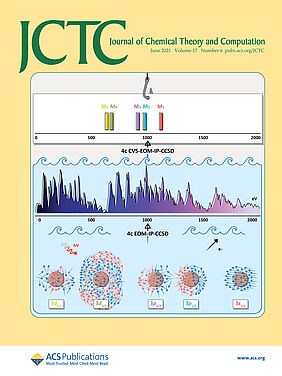A publication of PCMT team makes it to the cover of the Journal of Chemical Theory and Computation
PCMT Actualités scientifiques Vie du labo Parutions
In this work jointly conducted by Marta López Vidal, Sonia Coriani (Technical University of Denmark, Lyngby), Avijit Shee (University of Michigan, USA), Loïc Halbert, and André Severo Pereira Gomes (PCMT, PhLAM) the implementation in the Dirac program of the core–valence separation approach to the four-component relativistic Hamiltonian-based equation-of-motion coupled-cluster with singles and doubles theory (CVS-EOM-CCSD) for the calculation of relativistic core-ionization potentials and core-excitation energies is reported and benchmarked.
This implementation, which is based on a flexible framework for defining projection operators, enables the calculation of ionization and excitation energies for all four-component-based Hamiltonians available in Dirac, and consequently for approximate two-component and nonrelativistic Hamiltonians as well.
Benchmark calculations have been performed for Xenon and Iodine molecules. The results show that the heavier the atom, the larger the Breit and leading QED contributions (self-interaction and vacuum polarization). Therefore the latter high-order relativistic effects need to be included in the calculations in order to reach quantitative agreement with experimental data. This work has also shown that approximate two-component approaches can in general successfully reproduce the reference four-component results, with the exception of the K edge of the heaviest systems, for which two-electron picture change errors are non-negligible.
In summary, the four-component-based CVS-EOM-CCSD approach appears as a reliable methodology for investigating and predicting core-spectra throughout the periodic table.
Reference:
Loïc Halbert, Marta López Vidal, Avijit Shee, Sonia Coriani, André Severo Pereira Gomes
Relativistic EOM-CCSD for core-excited and core-ionized state energies based on the 4-component Dirac-Coulomb(-Gaunt) Hamiltonian
J. Chem. Theory Comput. 2021, 17 (6), pp.3583-3598
DOI: 10.1021/acs.jctc.0c01203.
Links:

